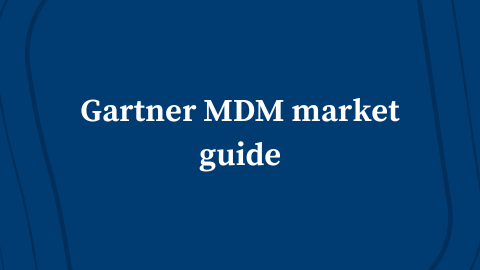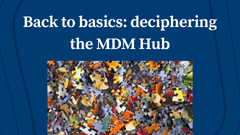
By Scott Moore, Director of Presales, Semarchy
Manufacturers are generating massive amounts of data via a tangled trail of machines, systems, and applications.
In fact, manufacturing companies generate more than 1800 petabytes of data per year, which is twice as much as the next closest industry. The major challenge for manufacturers is that heavy data loads from different, disconnected systems create a headache when it comes to managing that data effectively and obtaining a clear, accurate picture of it all.
Data scientists are spending 80% of their time preparing data for analysis rather than doing the actual analysis work, and the average organization has at least 31 different data sources feeding into their systems.
With many manufacturers having to reconsider their supply chains since Covid, reliable, efficient data to inform decision-making and help manufacturers manage risk is more important than ever.
Master Data Management for Supply Chain Management

Source: The Data Revolution for Manufacturing
Supply chain Master Data Management (MDM) provides manufacturers with a single, authoritative view of information impacting suppliers, and every other facet of the business. Effective supply chain MDM eliminates data silos that form across disparate sources and brings information together, so that you get a complete view with quality data.
Part of that process involves cleansing data and ensuring that all data is treated with consistency. For example, by categorizing data into key elements (suppliers, customers, products, etc.), those master data categories can be presented in a uniform and complete way.
Manufacturers with multiple data sources often find that data is treated differently at each source, making it difficult to get a trustworthy picture without considerable time spent on preparing data for analysis. This opens the door for inaccuracies and poor quality data.
Some typical challenges for manufacturers and supply chain management with poor quality data include:
-
- Disruption to the supply chain due to inaccurate forecasting
-
- Inaccuracies with inventory management, such as too much or too little of some products
-
- Sub-optimal scheduling and production decisions
-
- Security risks, especially where internal systems must be connected to external environments and sources of data
-
- Sub-optimal downtime on equipment, especially if maintenance data or alerts are siloed
A sound MDM program assists supply chain managers to achieve data completeness, helping to avoid these challenges. An ecosystem of quality data that is accessible across the supply chain can help manufacturers operate with more agility and get ahead of competitors.
Benefits of Supply Chain MDM
Why should manufacturers employ MDM for their supply chains? Take a look at these key benefits.
Improved data quality and accuracy
MDM integrates the data from different sources to provide a single source of truth. The program involves a structured process where data is sourced, cleansed, and integrated into a single repository for manufacturers to access.
Data standardization plays a pivotal role and helps to ensure that the information manufacturers are left with is useful and fit for the purposes for which they need it. Automated systems that pull information together and follow rules for cleansing and standardization of data help to eliminate human error and other inaccuracies in the data chain, and produce better quality data.
Enhanced visibility and traceability across the supply chain
Removing data silos helps to enhance visibility and traceability across the whole supply chain. For example, manufacturers can view data from the entire product lifecycle, from raw materials to final products, to customer insights about those final products. Supplier master data management software can also help manufacturer keep track of their supplier or vendor relationships.
This information can empower manufacturers to improve practices across the product lifecycle and deliver better customer experiences.
Streamlined operations and reduced lead times
MDM allows manufacturers to efficiently share accurate data across different processes and divisions in the business. This helps with collaborating, streamlining operations, and reducing lead times. People on various teams can more readily see what needs to be done and when.

Source: The Data Revolution for Manufacturing
Better decision-making
There’s a popular quote from Thomas Redman: “where there is data smoke, there is business fire.” The problem for manufacturers adrift in terabytes of sub-optimally managed data is that they often can’t yet see the signs that the data is showing them. Sometimes those business fires start before anyone realizes there was smoke.
MDM helps decision-makers to draw actionable insights from data much more readily and efficiently, allowing them to take a proactive approach. Decisions can be made based on data-driven insights before any “fires” start.
Cost savings and increased profitability
Through a combination of better quality data, a holistic view of operations, better visibility over regulatory issues, and the ability to be agile with decision-making, manufacturers can enjoy cost savings and increased profitability.
Key Elements of Effective MDM in Supply Chain Management
Here are the key elements that manufacturers should have in place for an effective supply chain MDM strategy.
Data governance framework
A data governance framework manages the security, integrity, availability, and usability of data. For example, your governance policies and procedures can help ensure that you comply with any regulatory requirements, and that your management procedures remain effective for producing high-quality data.
Data standardization and harmonization
Data standardization means that when you centralize the data from different sources, you eradicate accounting variations and have a consistent approach to how the data is presented. Data harmonization is slightly different in that it involves a reduction in accounting variations, but with an overall improvement in data quality and usability.
Data integration and consolidation
Data integration and consolidation means pooling data from different sources, systems, and applications into one centralized repository. The process of consolidation involves bringing the data into a uniform, usable state and weeding out duplicates or bad data.
Data stewardship and ownership
Data stewardship involves having set roles and responsibilities for ensuring that the MDM program is successfully implemented and that policies and practices are adopted. Data owners also take overall responsibility for the integrity of the data that they own. This is often on a department by department basis.
Continuous data quality management and monitoring
MDM is an ongoing project that requires consistent commitment of resources to manage data quality. The most successful MDM programs have a regular monitoring program to ensure that it is still producing trustworthy results for the company. The bottom line is that the data produced should directly assist with the goals the company has for the MDM program.
Steps to Implementing MDM in a Manufacturing Supply Chain
These are typical steps in setting MDM in-motion for a manufacturing supply-chain.
Assess the current state of data management
You’ve got to know where you’re starting from. Does your organization have the right resources and skill sets available to manage data well? What are your current challenges with data management, and what do you hope to achieve with an MDM program?
Identify gaps and opportunities for improvement
What are the gaps between your current state and your desired state of data management? What are your opportunities for improvement? For example, perhaps you’re hoping to better manage equipment downtime for maintenance, but you don’t have a centralized view of alerts or issues with equipment.
Develop a comprehensive MDM strategy
When you’ve assessed your current state, determined goals, and defined gaps, you can use those to start a roadmap for implementing MDM strategy in your organization. Components of an MDM roadmap can include:
-
- A summary of the issues you need to solve
-
- Your goals for MDM
-
- Your gap analysis
-
- Data governance strategy
-
- Change management strategy for the organization
-
- The technology you need
-
- A timeline and prioritized list of actions
Select the right MDM tools and technologies
Technology is the lynchpin of MDM implementation for supply chains. You need an MDM solution that will help you to reach your business goals, and that is as quick and efficient as possible to implement. As a manufacturing business, you may benefit in particular from the following types of tool:
-
- Employee Master Data Management software: Helps manufacturers maintain HR records and ensure compliance.
-
- Product Master Data Management software: Streamlines product information management for more efficient production and sales processes.
-
- Customer Master Data Management software: Enhances customer relationships and order fulfillment through data centralization.
-
- Location Master Data Management software: Optimizes supply chain and inventory management for multiple sites.
-
- Asset Master Data Management software: Tracks equipment, maintenance, and performance for reduced downtime.
Implement training and change management
There are some common reasons why digital transformation initiatives, including MDM programs, fail. One of those is that without adequate support for training and change management, people don’t buy into the new program, so don’t do what needs to be done to implement it successfully.
If you want MDM to succeed for your supply chain, you’ll need a robust plan for managing training and for gaining the support of impacted team members.
Monitor and measure the success of MDM initiatives
Monitoring and measuring against KPIs is essential if you want to ensure a successful MDM implementation. For example, are your processes and procedures delivering the desired results? Are people reporting any struggles? Ultimately, are you able to reach the goals you defined in the first place?
Case Studies of MDM in the Manufacturing Supply Chain
Chantelle Group is a long-established multi-brand company and creative studio. They have more than 10,000 points of sale worldwide, and needed to connect their multiple data sources to improve the agility of their operations and deliver a better customer experience. Semarchy xDI helped them to combine omnichannel data and to respond more quickly and flexibly to client requests.
Conclusion
Manufacturing supply chains rely on consistent, up-to-date, and reliable data to stay ahead of potential issues and provide transparency across the supply chain. Master Data Management helps to solve the issues with disparate sources of data and pull everything into a centralized source of truth.
MDM is the wave of the future for manufacturers. Emerging technologies such as AI are enhancing MDM capabilities further, helping manufacturers to get ahead of the competition. The bottom line is that MDM can help to solve for a number of business use cases while giving manufacturers a competitive advantage.
Would you like to know more about implementing manufacturing data management software or materials master data management software for your firm? Your first step is to contact Semarchy here.
Share this post
Featured Post
No featured post selected.












































